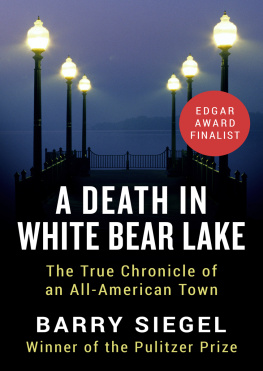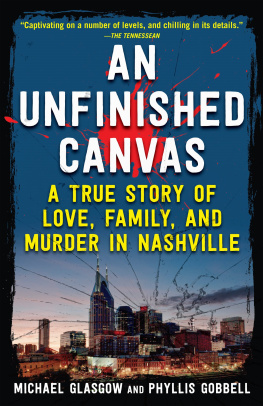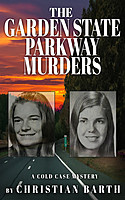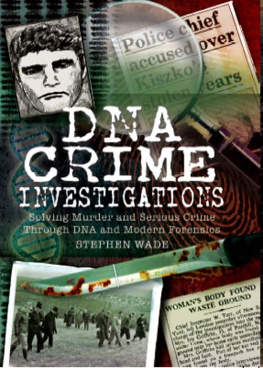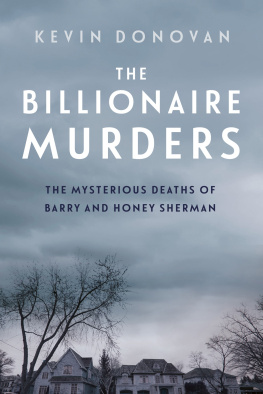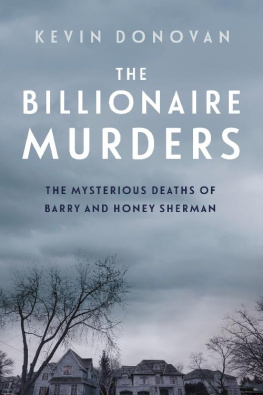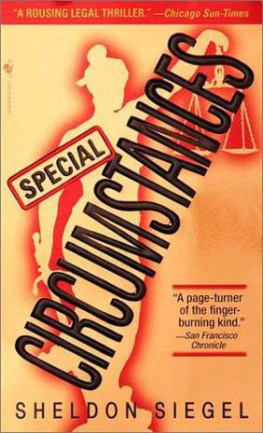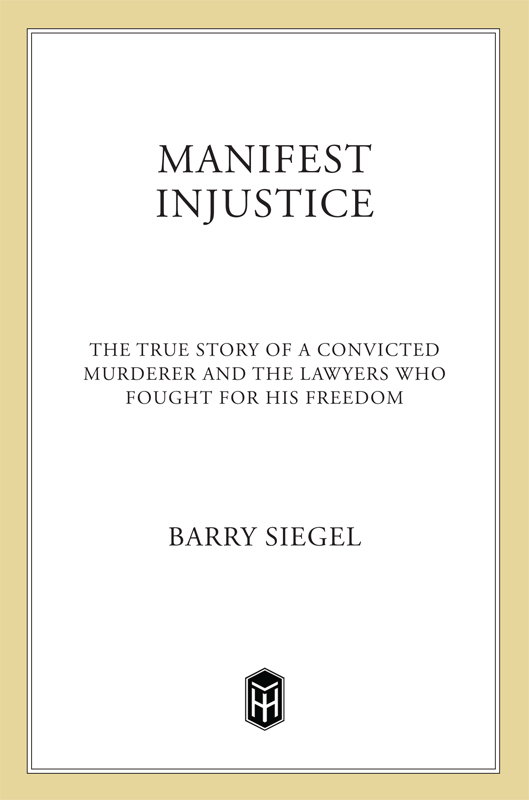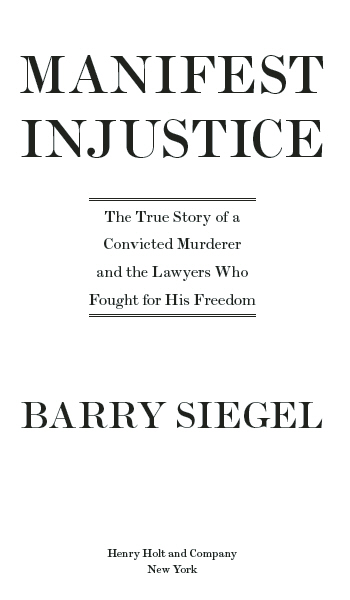
The author and publisher have provided this e-book to you for your personal use only. You may not make this e-book publicly available in any way. Copyright infringement is against the law. If you believe the copy of this e-book you are reading infringes on the authors copyright, please notify the publisher at: us.macmillanusa.com/piracy.
To my father, who showed me the way. With much love and admiration
Contents
Authors Note
In the summer of 2010, a scattering of news accounts drew my attention to the case of William Wayne Macumber, a seventy-five-year-old man who by then had served thirty-five years of a life sentence in Arizona State Prison for a double murder he very possibly did not commit. The case, rife with extraordinary irregularities, had attracted the sustained decade-long involvement of the Arizona Justice Project, one of the first and most respected of the nonprofit groups that now represent victims of manifest injustice throughout the country. By reputation, I knew of the Justice Projects founding director, Larry Hammond, a celebrated criminal and civil liberties attorney who had just been named winner of the prestigious 2010 Morris Dees Justice Award, given annually to a lawyer who has devoted his or her career to serving the public interest and pursuing justice, and whose work has brought about positive change in the community, state or nation. We arranged a phone conference and, on a Saturday morning late that June, talked for two hours. What I heard then, and subsequently discovered from my research, aroused in me an interest to write this book. I asked for Hammonds cooperation, and he readily agreed.
So began my unique relationship with the Justice Project team and, eventually, Bill Macumber. Without anyone saying so directly, it seemed clear that the Justice Project lawyers and I shared certain values and a mutual respect. Yet I was not on their defense team, and they werent my coauthors. As always between journalists and subjects, each party had its own goals and interests; there was a kind of unavoidable, collegial, unspoken maneuvering. The Justice Project associates naturally hoped to shape the narrative in a way favorable to their client, while I wanted accessintimate, authentic access. As a result, we found ourselves in a friendly yet careful kind of dance.
Larry Hammond, by nature impulsive and forthcoming, nonetheless gave careful thought to what hed reveal, openly telling me when he was thinking as a lawyer. His estimable Justice Project colleague Bob Bartels, a distinguished law professor at Arizona State Universitys Sandra Day OConnor College of Law, nicely but frankly informed me that if it were up to him, he wouldnt share anything. Yet eventually both did share and tell, in a series of enlightening conversations. So did a journalist turned private investigator, Rich Robertson, and a group of extraordinarily committed former law student volunteers, chief among them Karen Killion, Sharon Sargent-Flack and Jen Roach, who regularly rushed to assist the Macumber team long after theyd launched their own careers.
Each time I returned to Arizona, the door swung wider and the piles of documents on the counters of my home office grew higher. Yet the more I researched, the more I came to realize that my trove derived almost entirely from public documents chronicling events set well in the past. What I lacked was a detailed inner look at the Justice Projects ten-year effort on Macumbers behalf, started not long after Larry Hammond founded the organization. Good reason existed for this deficiency, of course: The case remained ongoing, with the Justice Project still serving as Macumbers lawyer. So barriers of confidentiality and attorney-client privilege stood between me and an understanding of the more recent efforts.
All the same, if I were to tell the story I had in mind, I needed both to chronicle the present and reconstruct the past. This I explained to Larry Hammond during a marathon four-day session we held in late February 2011 at his Phoenix law office, four days in which we talked constantly, morning to night, about the legal system, the Justice Project and the Macumber caseexcept when we stopped on a balmy Saturday afternoon to sneak in three innings of a spring training game between the Dodgers and Giants, baseball being Larrys other great passion besides social justice. Even there, with Hammond keeping a detailed scorecard, unabashed about his statistical fanaticism, I pressed him about my needs as he explained the fine points of legal confidentiality. I could tell he was at least listening and considering. Renegade might be too strong a word for Hammond, but he did seem a lawyer inclined to think outside the box. Whats more, he had his own compelling reasons for me to tell Macumbers story.
Our visit would prove pivotal. Days later, Hammond sent a message to his Justice Project team members, urging their full cooperation with me, even if that involved divulging client confidences and disclosing in detail some of the awkward reasons it had taken the project so long to file a petition on Macumbers behalf. I think we have a good story to tell, he explained. Bill Macumber has been briefed extensively on this question and he is in full accord and wants to waive the privilege.
With that, the locks came off the file cabinets. Three young, talented Justice Project attorneys, Katie Puzauskas, Lindsay Herf and Sarah Cooper, gathered around, excitedly offering accounts of their recent months out in the field, a girl team of lawyer-detectives going to the ground to track down witnesses from long ago. Katie, a vivacious twenty-seven-year-old of chiefly Italian descent; Lindsay, a sunny thirty-year-old college track and swim team jock; Sarah, an intense twenty-four-year-old wunderkind barrister with a strong British accenttogether they walked me through their still fresh investigation, spreading their reports on a conference room table, recalling details, setting scenes, building a chronology. The earlier Macumber team volunteers, the former law students Karen Killion, Sharon Sargent-Flack and Jen Roach, provided their accounts as well, along with piles of their notes and reports. Bill Macumber contributed, too, in a major way. After I spent a singular weekend visiting him at his Arizona State Prison home, a full Saturday and Sunday together from 9:00 A.M. to 4:00 P.M. each day, he decided to provide me with a thick file of personal letters and his entire four-hundred-page journal, a chronicle spanning his early life, arrest, conviction, and decades behind bars.
In this fashion, my understanding of the Macumber case and the Justice Projects efforts kept expanding. Inevitably, so did my evolving sense of ambiguity: The more I could see, the more complicated matters appeared. The complexities only deepened when I finally had the chance to meet with Macumbers ex-wife, Carol Kempfert. This case certainly involved a long list of strikingly dubious elements, as well as a convicted killer whose wit, erudition, calm decency and exemplary conduct (in prison and out) had inspired many to support him. Yet the record also included what seemed to be some quite damaging evidence against Bill Macumberhis own lawyer at trial had warned that the jury might not believe him because, though true, his account did sound fishy. So why Larry Hammonds passion and the Justice Projects unflagging decade-long commitment? By its nature, the cash-strapped Justice Project, with limited resources and manpower, had to be highly selective. The groups manifesto assigned to its staff only cases involving innocence or manifest injustice (obvious unfairness), and in reality, that alone wasnt enough: The Justice Project associates had to choose just those few cases where they could have an impact, where they could win. That theyd even selected the Macumber case was telling. That theyd stuck with it for more than a decade spoke volumes.


